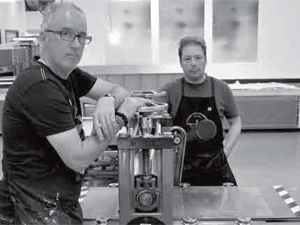
The University of Alberta's printmaking program is known the world over as one of the top programs of its kind.When students leave the U of A, they are not only academically versed in the history and theories behind the art form, but also among the most technically sound.
The development of the latter talent falls squarely on the shoulders of long-time printmaking demonstration technicians Marc Siegner and Steven Dixon.
"If it is about how to do it, then we're teaching it," said Dixon.
Dixon, who has been at the university for 26 years, and Siegner, closer to 30, have also given the department that continuity of knowledge that has spanned the decades. In return, the department has given them a home to pass along their wisdom and a place that continuously inspires.
"The U of A is a really stimulating environment," said Siegner, who, along with Dixon, are both working artists when time permits. "There is a lot you can tap into as far as your own research goes as far as the environment goes. It really keeps you thinking and moving."
Dixon agrees, adding his own creativity is helped along by a cohesive department and colleagues that are very supportive of what each other is trying to do.
"I don't know if it's that [department administrators] have had the wisdom to hire the right people or it has just been serendipitous, but somehow we have a good group of people who have worked together for a long time, trust each other, respect and support each other, and who try as much as possible to be inclusive."
The pair teach all-things technical in the department's four areas of printmaking-silkscreen, lithography, relief and intaglio-while facilitating grad students in their courses of study and helping out with a wide range of requests from people across campus. They also maintain the facilities, recommend changes, help chart the direction of the studio and provide the department with consistency in the face of academic turnover and wisdom on how to handle new technology. Over the years, the pair say they have watched printmaking embrace the digital era, but only to aid the art form's previous technologies, not replace them.
"In printmaking, we don't throw out old technology, we tend to keep it around because it is still useful," said Dixon. "This is part of the challenge of our job, because you move in new equipment, you have to learn that on top of all the new programs, but nothing is ever thrown away. On a typical day I might be working on a letter press hand-setting type and move from that to etching, to setting up files for digital printing."
Another strength of the program, Dixon says, is the immersion of the students in the full slate of print media, a practice that provides students with a solid foundation of expertise and helps the department guard against "little kingdoms of printmaking" where the different styles are the domain of one instructor in often geographically separate facilities.
"I've seen programs that end up with artificial divisions," said Dixon. "Here, it is one large studio. There are divisions but they are invisible, so you effectively walk from one studio to the next.
"One of the great strengths of the program is being able to mix it all together and keep everything separate at the same time."